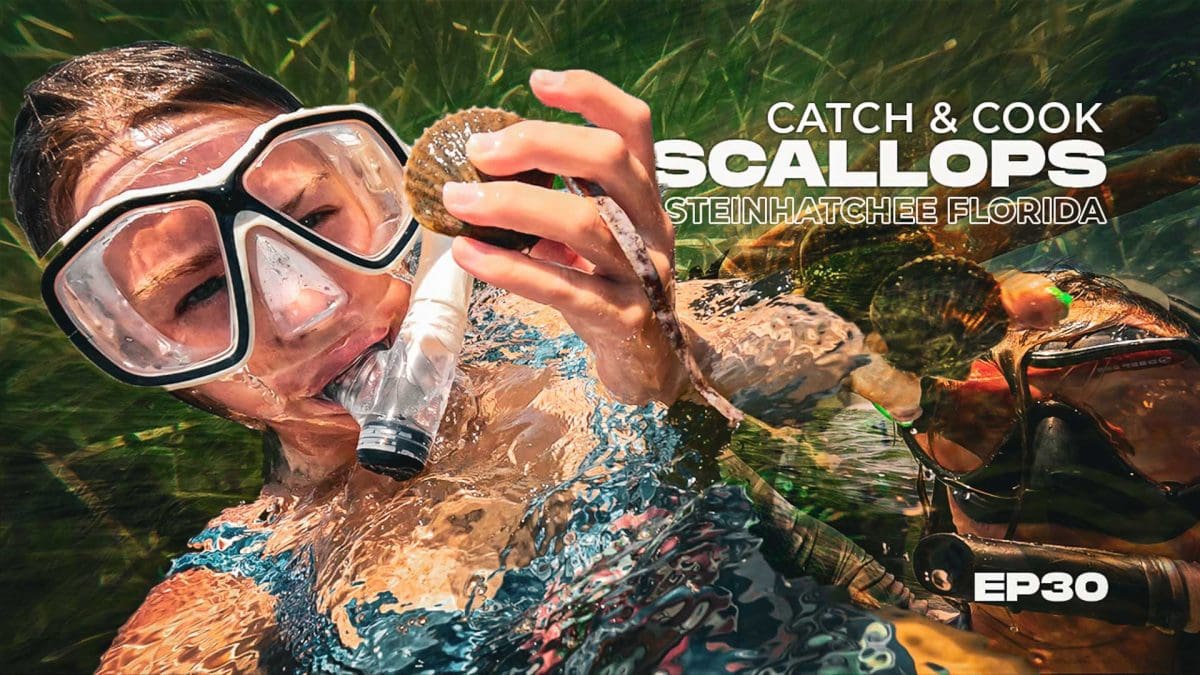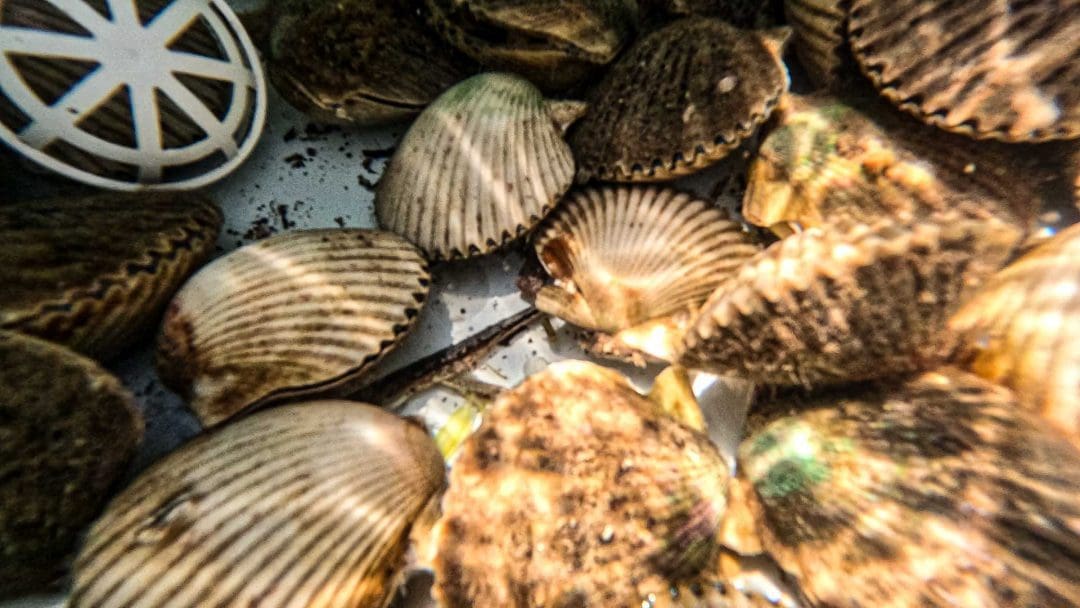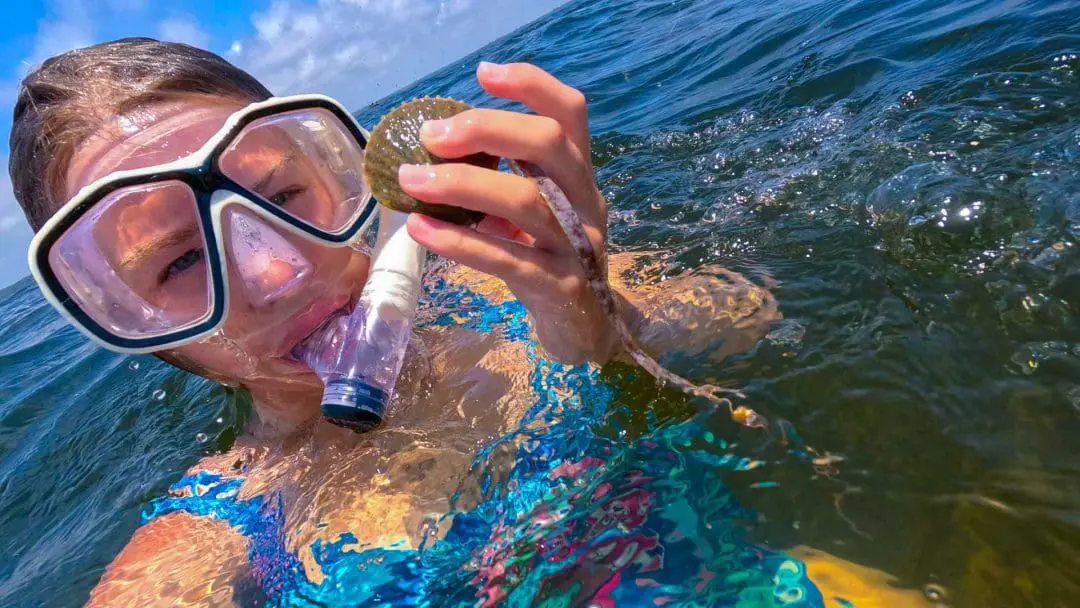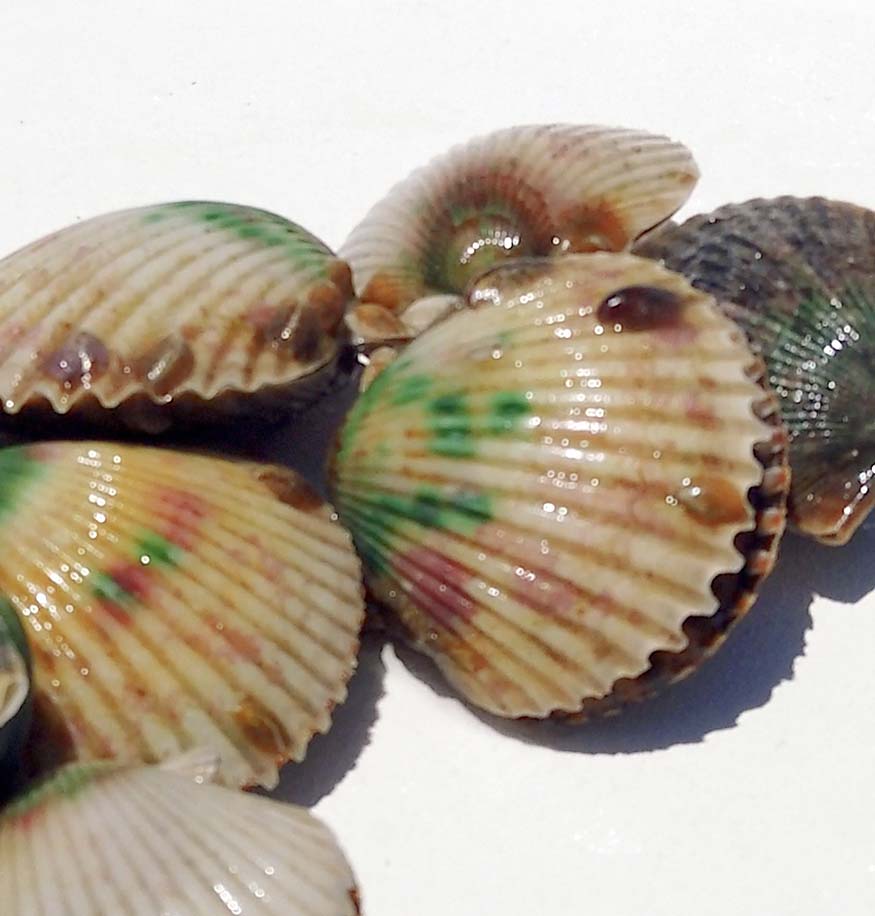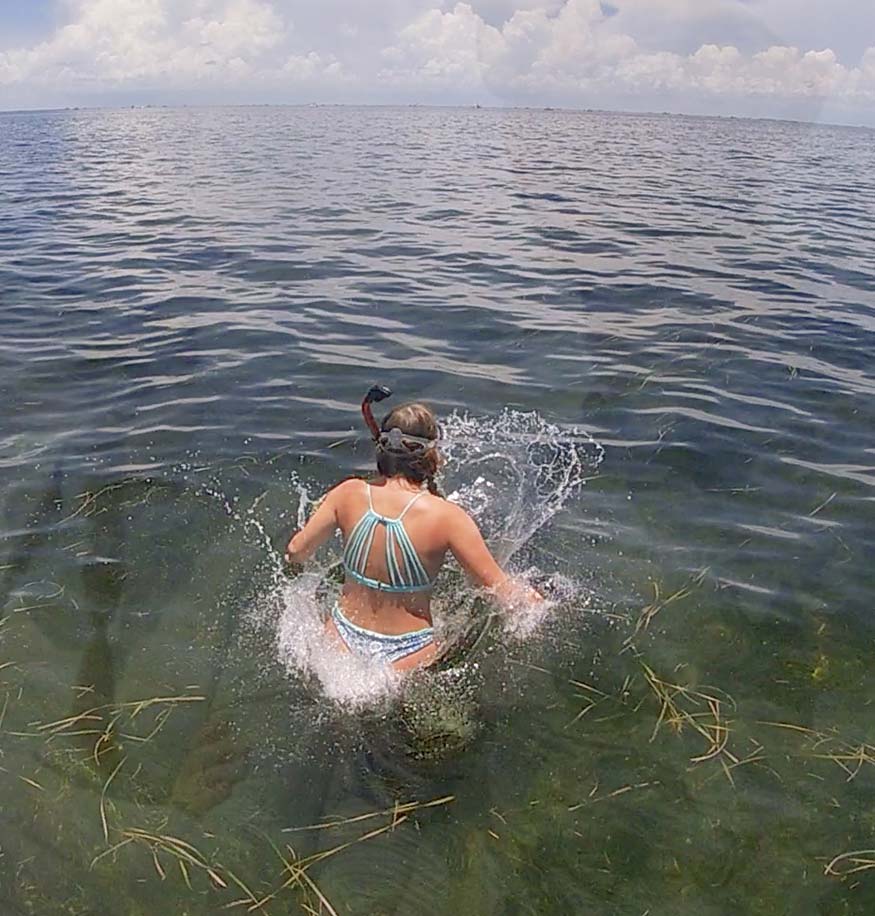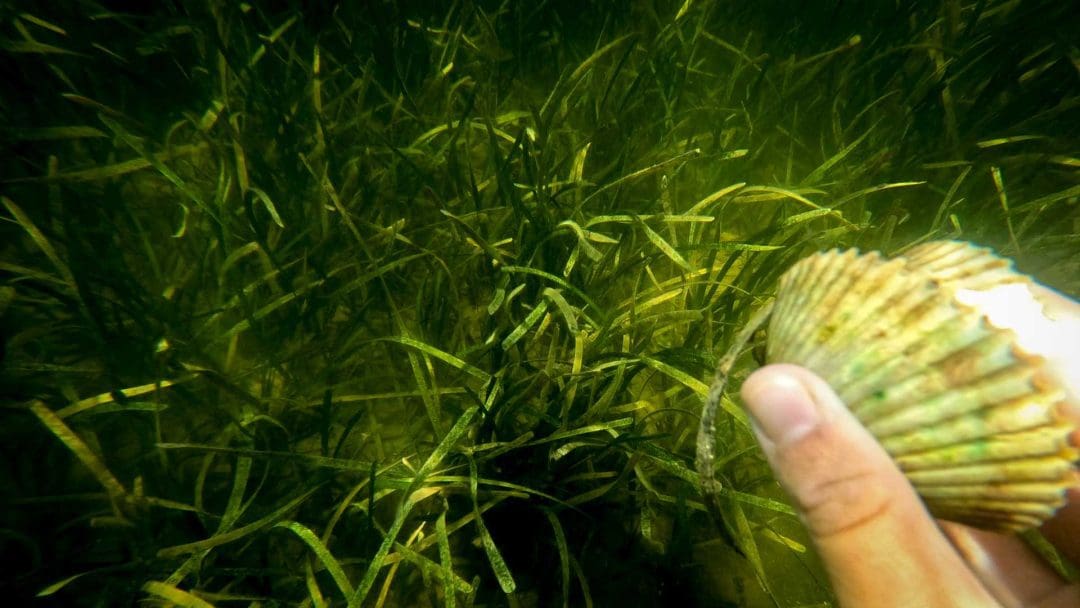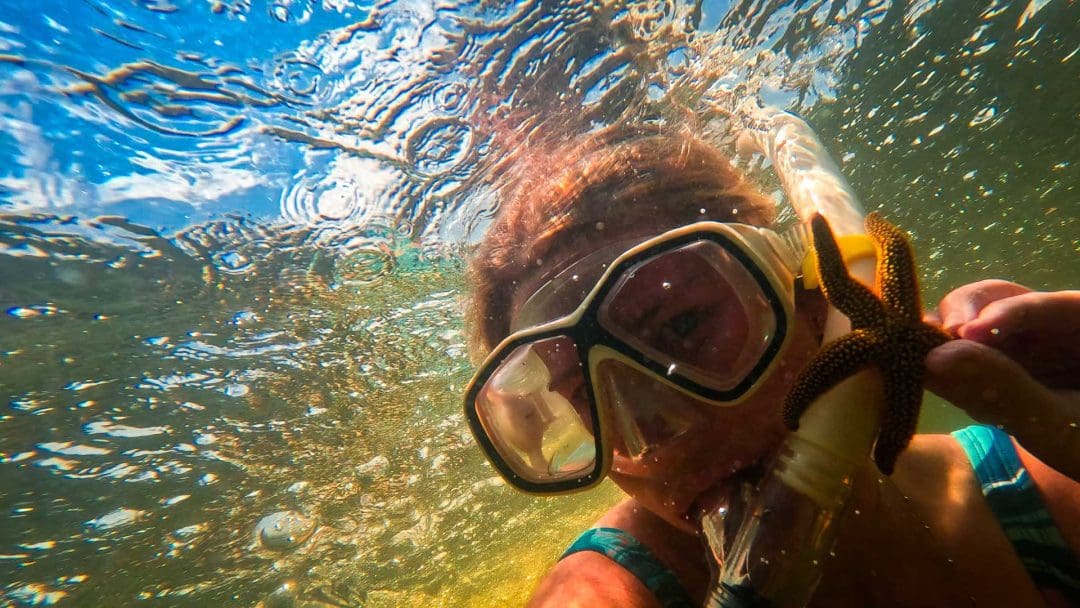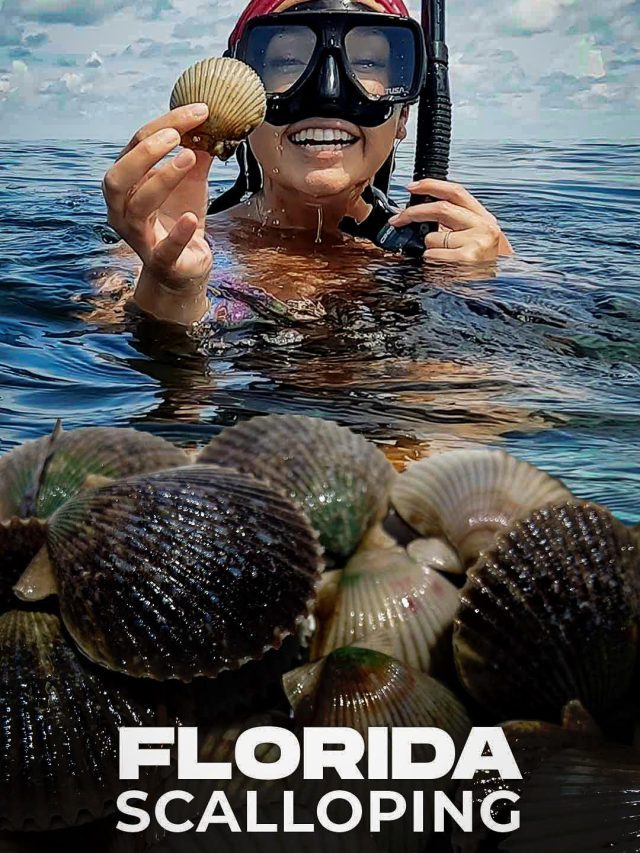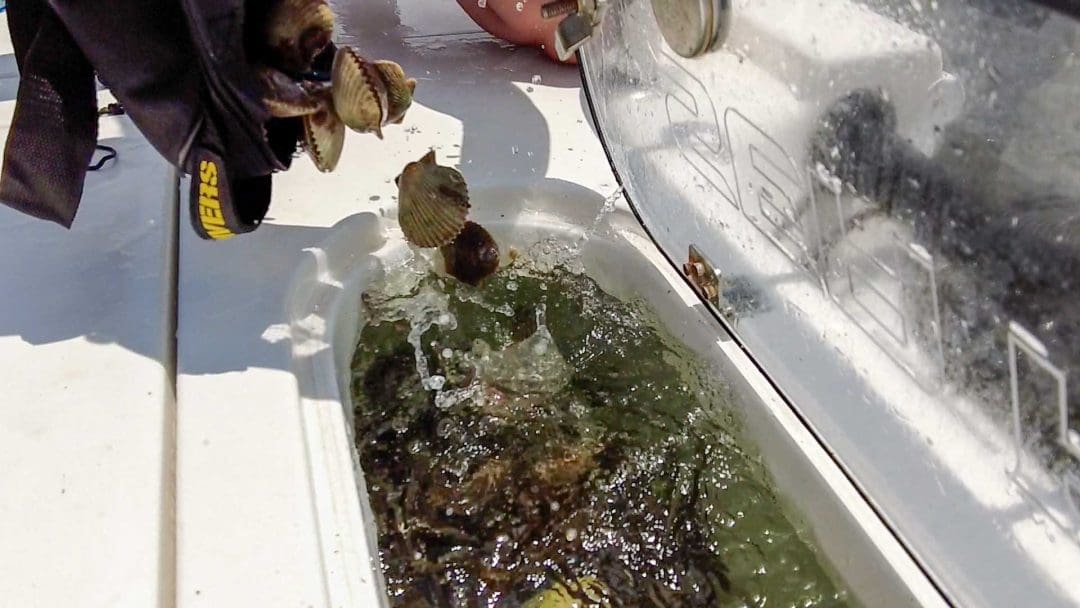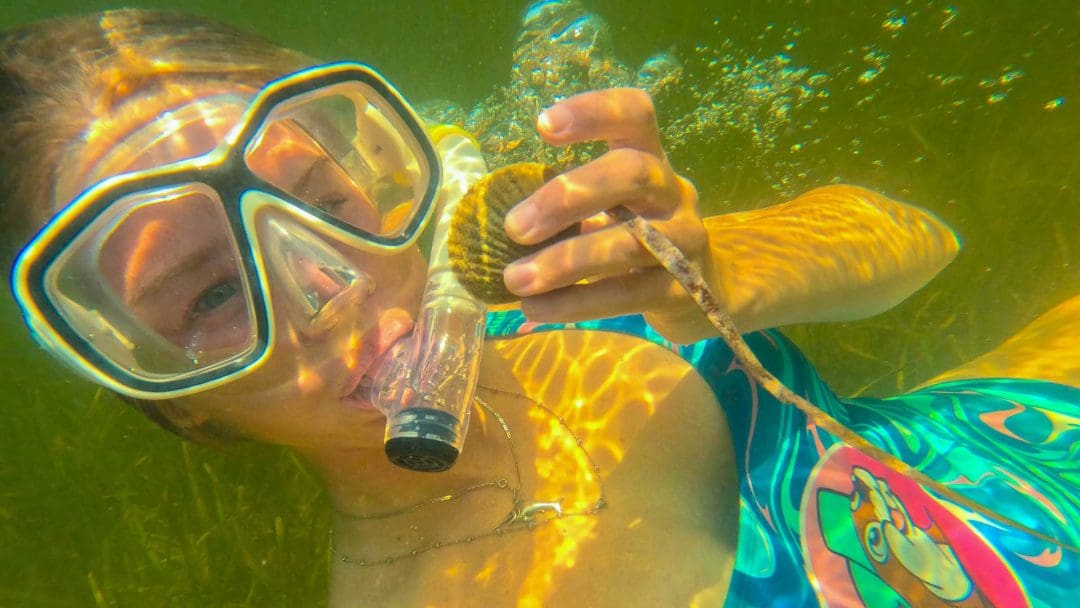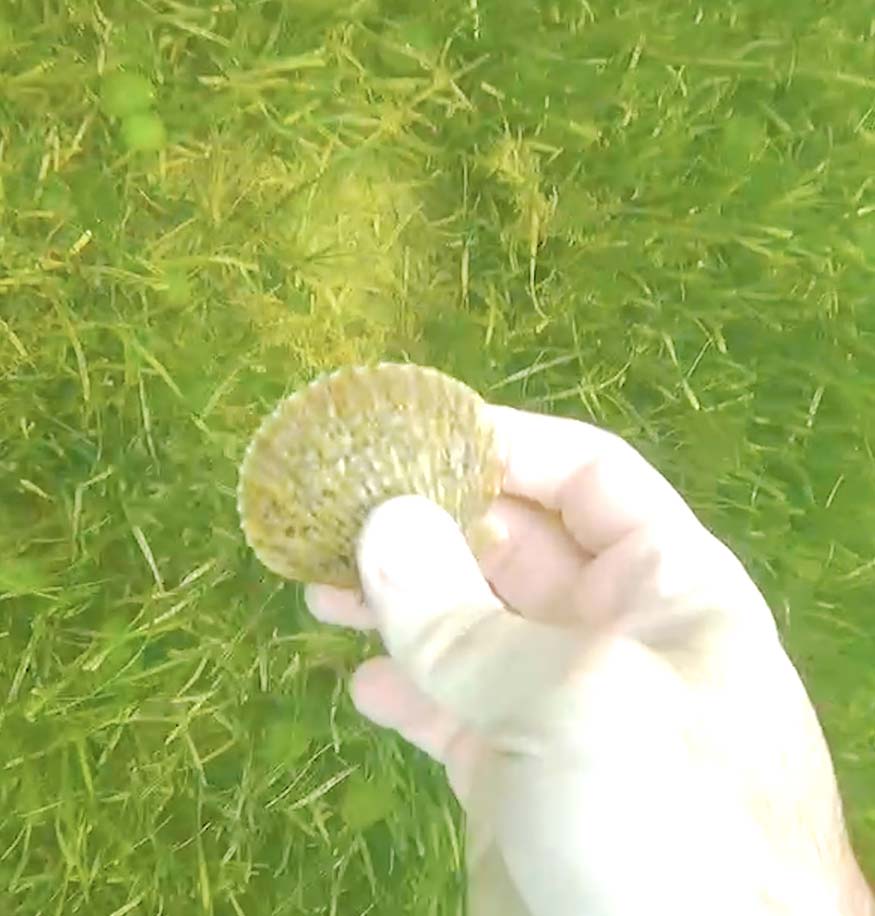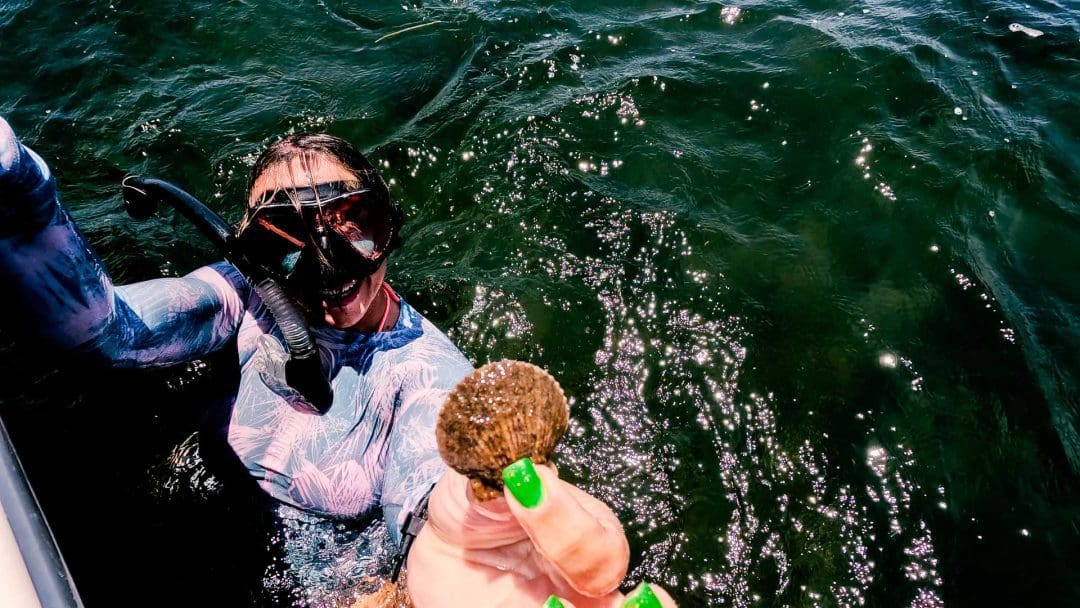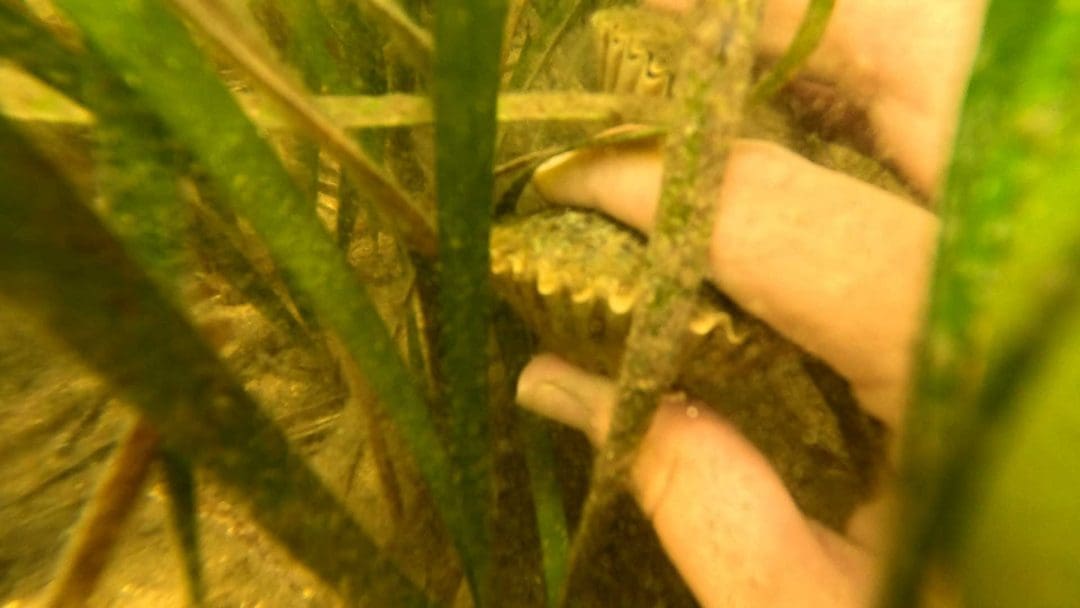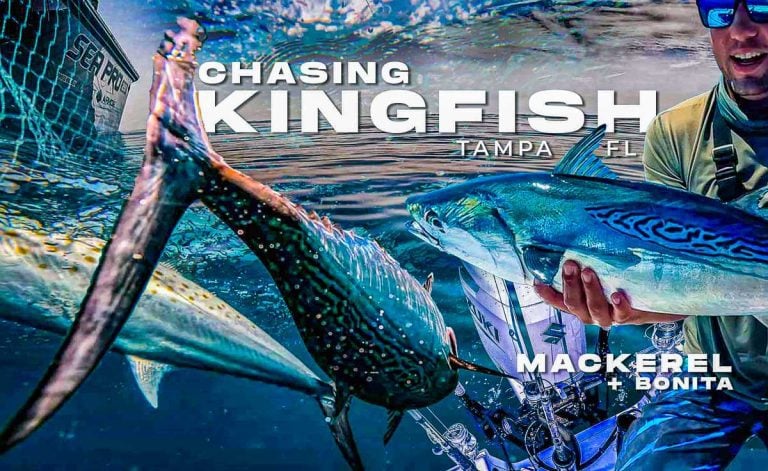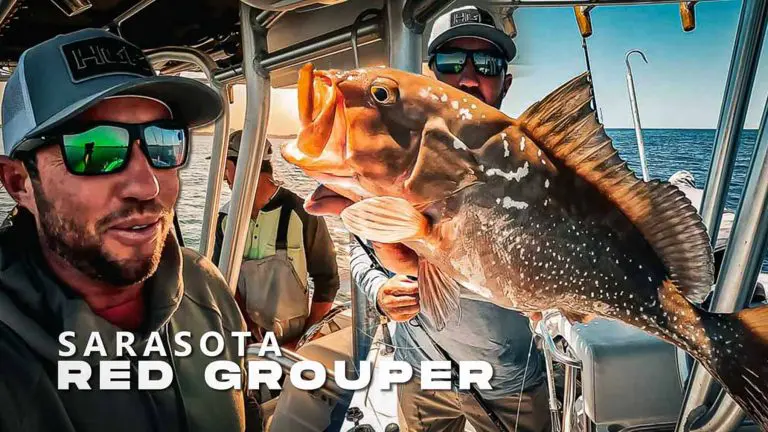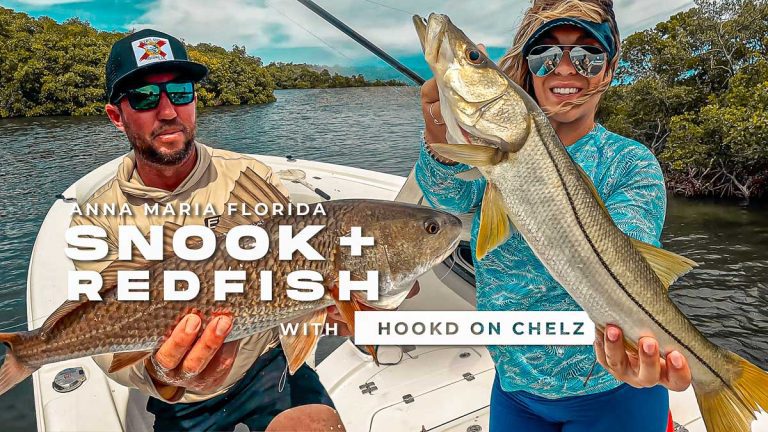Florida’s Gulf Coast is synonymous with sunshine, beautiful beaches, and an array of water activities. Among these, scalloping stands out as a unique and exciting adventure, offering both locals and visitors the chance to engage in an underwater hunt for these delectable treasures.
Watch Video: Steinhatchee, FL Scalloping
Book a Scalloping Trip:
Where and When to Go Scalloping
The prime scalloping grounds span from the northern reaches of the Panhandle down to the warm waters of the Florida Keys, with hotspots including Crystal River, Homosassa, and Steinhatchee. The season typically runs from early July to late September, but this can vary slightly by location.
What are Florida Scallops?
Florida scallops, scientifically known as Argopecten irradians, are a species of bivalve mollusks that inhabit the coastal waters of the Sunshine State. They are characterized by their distinctive fan-shaped shells, which range in color from pale orange to deep red. These remarkable creatures not only serve as a vital component of the marine ecosystem but also provide endless enjoyment for avid scallopers.
Scalloping in Florida: Gulf of Mexico
Florida is known for its abundant scallop populations and the thrill of scalloping season, where an underwater adventure awaits you! Prepare for an unforgettable experience as you explore our crystal-clear waters and embark on an exciting scalloping adventure.
What are Scallops?
Scallops are bivalve mollusks that belong to the Pectinidae family. They have two hinged shells and can swim by rapidly opening and closing their shells, propelling themselves through the water.
What is Scalloping?
Imagine an Easter egg hunt, but underwater and with the reward being tasty mollusks known for their rows of enchanting blue eyes.
Scalloping is an annual summer tradition in Florida, blending the thrill of the hunt with the joy of a day spent on the water.
Florida’s crystal-clear coastal waters provide the perfect environment for this exciting endeavor.
The Florida Scalloping Season
Dates and Regulations
To ensure the sustainability of scallop populations, the Florida Fish and Wildlife Conservation Commission (FWC) has established specific guidelines and regulations for scalloping.
The season typically runs from July to September, allowing visitors and locals alike to indulge in this thrilling pursuit.
However, it’s important to stay updated with the current regulations, as they may vary from year to year. Always consult the FWC website or a local bait and tackle shop for the most recent information before embarking on your scalloping adventure.
| Scallop Zone | Open Season Dates |
|---|---|
| St. Joseph Bay | August 16 – September 24 |
| St. Andrew Bay | July 1 – September 24 |
| Gulf County | August 16 – September 24 |
| Steinhatchee | June 15 – September 10 |
| Suwannee | June 15 – September 10 |
| Hernando | July 1 – September 24 |
| Citrus | July 1 – September 24 |
| Levy | July 1 – September 24 |
| Pasco | July 1 – September 24 |
| Anclote | July 1 – September 24 |
| Crystal River | July 1 – September 24 |
| Homosassa | July 1 – September 24 |
| Ozello | July 1 – September 24 |
**These dates are subject to change, and it’s a good idea to check for any updates or additional regulations from the Florida Fish and Wildlife Conservation Commission (FWC) before planning your scalloping trip.
Popular Places to Find Scallops
Snorkeling in the warm, turquoise waters of the Gulf of Mexico or the Atlantic Ocean, searching for these delectable treasures nestled in seagrass beds. It’s an adventure that’s great for family, friends and group trips, combining exploration, discovery, and culinary delight.
Steinhatchee Florida Scalloping & Fishing
Crystal River, FL
Crystal River, located on Florida’s Nature Coast, is renowned as one of the prime scalloping destinations in the state. From July through September, the crystal-clear waters of Crystal River offer ideal conditions for scalloping enthusiasts.
This charming coastal town provides a unique opportunity to witness an abundance of marine life while enjoying the thrill of scallop hunting.
Homosassa, FL
Adjacent to Crystal River, you’ll find another scalloping paradise: Homosassa. With its picturesque coastal landscapes and diverse marine ecosystem, Homosassa is a must-visit destination for scalloping enthusiasts.
The scenic Homosassa River and its surrounding areas offer ample opportunities to spot these elusive creatures and immerse yourself in the wonders of nature.
Steinhatchee, FL
For those seeking a more remote and tranquil scalloping experience, Steinhatchee is the perfect destination. Situated on Florida’s Big Bend, Steinhatchee boasts pristine waters teeming with scallops during the peak season.
As you venture into this unspoiled coastal haven, you’ll be captivated by the breathtaking beauty of the Gulf of Mexico and the thrill of discovering scallops in their natural habitat.
Ideal Locations for Scalloping
Crystal River
Known for its clear waters and abundant scallop populations, it’s a perfect spot for beginners and experienced scallopers alike.
Homosassa
Favored by many for its old-town charm and less crowded spots, it’s a great choice for a more authentic experience.
Keaton Beach
These areas are known for their shallow waters, making them ideal for families and those new to scalloping.
Scalloping in Florida is more than just an adventure; it’s an experience that blends fun, conservation, and the culinary arts into a memorable day on the water.
Whether you’re a seasoned scalloper or trying it for the first time, the Sunshine State’s scalloping season offers something for everyone.
Homosassa, Crystal River Scalloping & Fishing
Scalloping is popular in coastal regions around the world, with notable hotspots including Florida, the Gulf of Mexico, the Caribbean, and parts of Europe.
Unlike commercial scallop harvesting, which often involves dredging or trawling, recreational scalloping is typically done by snorkeling or free-diving. It is a sustainable and eco-friendly way to enjoy these delectable shellfish.
Experience the Thrill of Scalloping in Sunny Florida
As you search for scallops, you’ll be entertained by the stunning underwater landscapes and the colorful array of fish and sea creatures that call these waters home. Explore the turquoise waters of the Gulf of Mexico or the picturesque shores of the Atlantic Ocean—Florida offers scalloping destinations for every preference.
After a rewarding day of scalloping, indulge in the sweet and succulent flavors of your hard-earned harvest. Learn a few ways to prepare scallops.
Pack your snorkel gear, bring your sense of adventure, and get ready to embark on an extraordinary scalloping experience in Florida’s magnificent waters. Whether you’re an experienced scalloper or a first-time adventurer, Florida invites you to discover the enchantment that awaits you beneath the surface. Come and experience scalloping season in the Sunshine State—Florida is calling!
Planning Your Florida Nature Coast Scalloping Trip
Before embarking on your scalloping adventure, it’s essential to plan and prepare accordingly. Here are some crucial steps to ensure a successful and enjoyable trip:
Making the Most of Your Catch
After a successful day of scalloping, the next step is to enjoy your bounty. Some choose to cook their scallops themselves, reveling in the fresh taste that only comes from a catch you’ve harvested with your own hands. For those less inclined to the culinary arts, several local eateries offer to cook your catch, allowing you to enjoy a delicious meal without the hassle.
Preparing for Your Scallop Expedition
Essential Scalloping Equipment
Before you dive in, there are a few essentials you’ll need to sort out
Licenses
Residents and non-residents need a fishing license to scallop, with costs varying based on the type and duration of the license. If you’re going with a licensed captain or guide, your license is usually included in the trip.
Gear
Basic gear includes a mask, snorkel, fins, and a mesh bag to hold your catch. Scallops must be collected by hand or with a landing/dip net.
Regulations
Familiarize yourself with the bag limits, which can differ by area and are strictly enforced to preserve scallop populations. Always display a dive flag for safety, indicating that divers are in the water.
Mask, Snorkel, and Fins:
These are indispensable tools for observing and maneuvering underwater with ease.
Mesh Bag or Diving Bucket:
Ideal for storing your scallop catch while allowing water to circulate.
Sunscreen and Hat:
Protect yourself from the Florida sun’s relentless rays with adequate sun protection.
Cooler with Ice:
Keep your scallops fresh by placing them on ice as soon as possible after harvesting.
Dive Flag:
A legal requirement, the dive flag ensures your safety by alerting boaters to your presence in the water.
Safety Considerations
While scalloping is an exhilarating experience, it is crucial to prioritize safety during your adventure. Here are some essential safety tips to keep in mind:
Buddy System:
Never venture into the water alone. Always scallop with a buddy, ensuring that you can assist each other if needed.
Stay Hydrated:
Florida’s summer temperatures can be scorching. Stay hydrated by drinking plenty of water throughout your scalloping expedition.
Watch for Boats:
Keep a vigilant eye on passing boats and ensure your dive flag is visible at all times.
Choose the Right Time
Timing is crucial when planning your scalloping trip. The season typically runs from June to September, with July and August being the peak months for scallop harvesting. Checking the official FWC website for updates and monitoring local weather conditions can help you choose the best time to visit the Florida Nature Coast.
The Art of Scalloping
Spotting Scallops
When you’re in the water, keep a keen eye out for the telltale signs of scallops. These remarkable creatures possess a unique ability to camouflage themselves by clapping their shells together. Look for the distinct fan-shaped shells, often adorned with beautiful hues of orange and blue. Scallops tend to inhabit seagrass beds, so search for them among the swaying blades of seagrass.
Scallop Harvesting Techniques
Once you’ve spotted a scallop, it’s time to harvest it. Gently dive down and cradle the scallop in your hand. Remember to respect the environment and only collect scallops that meet the legal size requirements. The FWC regulates the size and quantity of scallops that can be harvested, ensuring the sustainability of this cherished activity.
Observation:
Slowly glide through the seagrass beds, scanning the sandy patches for the telltale signs of scallops. Look for their vibrant shells and the occasional fluttering motion.
Approach Carefully:
Once you spot a scallop, approach it calmly and avoid making sudden movements. Start by gently extending your arm and placing your hand behind the scallop.
Scoop and Capture:
With a swift but gentle motion, scoop the scallop from behind and gently lift it into your mesh bag or diving bucket.
Scallop Size Matters:
Familiarize yourself with the minimum size limit for scallops. Always return undersized or juvenile scallops to the water, allowing them to mature and contribute to the population growth.
Florida’s Nature Coast Scalloping Trips offer an extraordinary opportunity to immerse yourself in the natural beauty of the region while enjoying the thrill of scalloping.
With its crystal-clear waters, diverse marine life, and stunning underwater scenery, the Florida Nature Coast is truly a hidden treasure waiting to be explored. Plan your scalloping trip carefully, follow the regulations, and prepare for an unforgettable adventure in this aquatic paradise.
Local Scallop Guides, Services and Charters
Local scallop guide services and charters offer expert guidance, equipment, and local knowledge for day trips or vacation adventures centered around scalloping. These services provide valuable expertise on the best scallop locations, techniques, and safety measures, enhancing your scalloping experience.
Book a Scalloping Trip:
Some charters may offer all-inclusive packages, including equipment, guided tours, and onboard amenities, ensuring a convenient and enjoyable outing. Hiring a guide or charter maximizes your chances of success while complying with regulations and sustainable practices.
Tips for Cooking Scallops
After an exhilarating day of scalloping, it’s time to savor the fruits of your underwater treasure hunt. Scallops are incredibly versatile and can be prepared in numerous mouthwatering ways. From searing them to perfection with a sprinkle of lemon zest to adding them to a refreshing ceviche, the culinary possibilities are endless. Let your creativity run wild as you transform these delectable morsels into a memorable meal.
When cooking scallops at home, there are a few common issues that people may encounter. Here are five of the most common issues and some helpful guidance to overcome them:
Overcooking Scallops:
Overcooking scallops can result in a rubbery texture and loss of flavor.
To avoid this, cook scallops just until they turn opaque and firm, usually within 2-3 minutes per side.
Keep a close eye on them and remove them from the heat as soon as they are done.
Scallops Sticking to the pan:
Scallops have a tendency to stick to the pan if it’s not properly heated or if the pan is not non-stick.
To prevent sticking, make sure your pan is hot before adding the scallops. Preheat the pan over medium-high heat, add a small amount of oil with a high smoke point (such as canola or grapeseed oil), and let it heat up before adding the scallops.
You can also try using a non-stick pan or a well-seasoned cast-iron skillet.
Uneven cooking:
If your scallops are not cooking evenly, it could be because they are of different sizes.
To ensure even cooking, try to select scallops that are similar in size.
If they vary in thickness, you can gently press them down with a spatula while cooking to help them cook more evenly.
Lack of sear or caramelization:
Achieving a beautiful golden sear or caramelization on scallops can be challenging.
To enhance browning, make sure your scallops are dry before cooking. Pat them dry with a paper towel to remove excess moisture. Additionally, avoid overcrowding the pan, as this can cause the scallops to steam instead of sear.
Cook them in batches if necessary, giving each scallop enough space to develop a good crust.
Seasoning Scallops:
Scallops have a delicate flavor, so it’s essential to season them properly. Season them with salt and pepper just before cooking, or you can marinate them in a simple mixture of olive oil, lemon juice, garlic, and herbs for added flavor. **Remember not to over-season, as it can overpower the natural taste of the scallops.
Popular Ways to Prepare Scallops
Grill, pan-sear, or incorporate them into mouthwatering seafood dishes. It’s not just about the feast—it’s about creating cherished memories with loved ones, basking in Florida’s coastal beauty, and reveling in the joy of exploration.
3 Important Tips When Cooking Scallops at Home:
Ensure Dry Scallops:
Moisture is the enemy when it comes to achieving a good sear on scallops. Before cooking, make sure to thoroughly pat the scallops dry with a paper towel.
Excess moisture on the surface of the scallops can prevent them from browning properly and result in a less desirable texture.
Use High Heat:
Scallop cooking times are relatively short, and high heat is essential to achieve a caramelized crust while keeping the interior tender.
Whether you’re pan-searing or grilling, preheat your cooking surface to a medium-high to high heat setting. This will allow for a quick sear and preserve the scallops’ juiciness.
Be Careful Not to Overcook Scallops:
Scallops are delicate and can become tough and rubbery if overcooked. Keep a close eye on them while cooking and aim for a slightly translucent center. The scallops should turn from translucent to opaque as they cook, and their texture should remain tender.
Overcooking even by a minute or two can make a significant difference, so be mindful of the cooking time to ensure perfectly cooked scallops.
Common Ways to Cook Scallops
There are many delicious ways to prepare scallops. Here are five popular methods:
Pan-Seared Scallops:
This is a classic and simple method that brings out the natural sweetness of scallops.
• Start by patting the scallops dry with a paper towel to ensure a nice sear.
• Heat some oil or butter in a skillet over medium-high heat
Cook the scallops for about 2-3 minutes per side until they develop a golden-brown crust.
Grilled Scallops:
Grilling adds a smoky flavor to scallops and gives them a slightly charred exterior.
• Preheat the grill to medium-high heat. Toss the scallops with a little oil, salt, and pepper.
• Skewer them or use a grilling basket to prevent them from falling through the grates.
• Grill for 2-3 minutes per side until cooked through.
Scallops in Garlic Butter Sauce:
This recipe adds a rich and flavorful twist to scallops.
• Melt butter in a skillet over medium heat and add minced garlic.
• Sauté for a minute until fragrant.
• Add the scallops and cook for 2-3 minutes per side until they are opaque and cooked through.
• Finish with a squeeze of lemon juice and garnish with fresh herbs like parsley or chives.
Scallops with Citrus Salsa:
This preparation adds a vibrant and refreshing touch to scallops.
• Prepare a salsa by combining diced oranges, grapefruits, or any citrus fruit with finely chopped red onion, jalapeño, cilantro, and a splash of lime juice.
• Season with salt and pepper.
• Sear the scallops following the pan-seared method mentioned above and serve them topped with the citrus salsa.
Scallops in Creamy Sauce:
For a decadent and luxurious dish, consider making scallops in a creamy sauce.
• Sauté scallops in butter until browned and cooked through, then remove them from the pan.
• In the same pan, add minced shallots and cook until softened.
• Pour in some white wine or broth and let it reduce slightly.
• Add heavy cream and simmer until the sauce thickens.
• Season with salt, pepper, and herbs like tarragon or dill.
• Return the scallops to the pan briefly to coat them in the sauce, and serve.
How to Tell Scallops are Done Cooking
To determine when scallops are done cooking, there are a few visual and tactile cues to look out for:
Scallop Texture:
Cooked scallops should have a tender and slightly springy texture.
They should be firm to the touch but still have a slight give when pressed gently. Overcooked scallops tend to become tough and rubbery.
Scallop Color:
Raw scallops have a translucent or slightly opaque appearance.
As scallops cook, they turn from translucent to an opaque, milky white color. The change in color is an indication that the scallops are cooked through.
Searing Scallops:
If you’re pan-searing scallops, a golden-brown sear on the outside is a good indication that they are cooked.
The scallops should develop a caramelized crust while retaining their tender texture inside.
Here are a few tips regarding the thickness or size of scallops and their corresponding cooking times:
Consider the Size:
Scallops come in various sizes, such as small, medium, or large. The size of the scallops will impact the cooking time.
Larger scallops will generally require slightly longer cooking times compared to smaller ones. Adjust your cooking time accordingly to ensure even cooking throughout.
Opt for Uniform Size:
When cooking scallops, it is ideal to have scallops of similar thickness or size to ensure even cooking. This helps to prevent some scallops from being undercooked while others become overcooked.
If your scallops are of different sizes, you can separate them into groups based on size and cook each group separately to achieve consistent results.
Adjust Cooking Time:
As a general guideline, scallops typically cook quickly, usually within 2-4 minutes per side. However, the exact cooking time will depend on the thickness or size of the scallops.
Thinner or smaller scallops will cook faster, while thicker or larger ones will require slightly more time. It’s crucial to monitor their appearance and texture during cooking.
Look for a golden-brown sear on the outside and a slightly translucent center for perfectly cooked scallops.
Use Visual Cues:
Visual cues are essential when determining the doneness of scallops. While cooking, observe the color and texture changes.
The scallops will turn opaque and firm up as they cook. Avoid overcooking them as it can result in a rubbery texture.
Remove the scallops from the heat just before they are fully cooked through, as residual heat will continue to cook them for a short while after they are removed from the heat source.
Remember, these tips are general guidelines, and factors such as the cooking method, heat source, and personal preference can also influence cooking times. It’s always best to keep a close eye on the scallops and adjust the cooking time accordingly to achieve the desired preference.
Remember to adjust cooking times based on the size of your scallops, as they can vary. Enjoy your scallops prepared in these delicious ways!
Scalloping Frequently Asked Questions (FAQs)
What is the best time to go scalloping in the Florida Nature Coast?
The peak scalloping season in the Florida Nature Coast runs from June to September, with July and August being the best months to go scalloping. During these months, the scallops are plentiful, and the weather conditions are ideal for snorkeling.
Do I need a license for scalloping in the Florida Nature Coast?
Yes, you need a saltwater fishing license with a recreational shellfish harvest endorsement to legally engage in scalloping in the Florida Nature Coast. It’s important to obtain the necessary permits from the Florida Fish and Wildlife Conservation Commission (FWC) before your trip.
Can I keep the scallops I catch while scalloping?
Yes, you can keep the scallops you catch while scalloping in the Florida Nature Coast, provided they meet the size and bag limit regulations set by the FWC. Currently, the limit is 2 gallons of whole scallops or 1 pint of meat per person per day.
Are there any restrictions on scalloping in the Florida Nature Coast?
Yes, there are certain restrictions in place to protect the scallop population and preserve the ecosystem. It’s important to familiarize yourself with the regulations, such as size and bag limits, as well as designated scallop harvest areas. The FWC website provides detailed information regarding these restrictions.
What should I bring on a scalloping trip?
For a successful and comfortable scalloping trip, it’s recommended to bring snorkeling equipment (mask, snorkel, and fins), a mesh bag for your scallop harvest, a dive flag for safety, sunscreen for sun protection, and plenty of water and snacks to stay hydrated and energized.
Are there guided scalloping tours available in the Florida Nature Coast?
Yes, there are various guided scalloping tours available in the Florida Nature Coast. These tours offer a convenient and informative way to explore the scalloping grounds while benefiting from the expertise of experienced guides. They provide all the necessary equipment and can enhance your overall scalloping experience.

